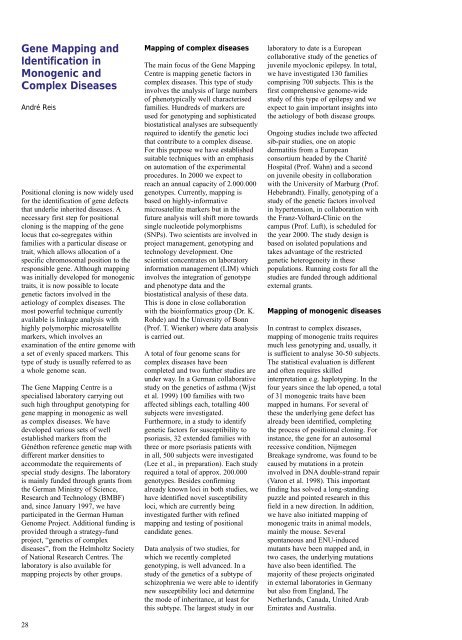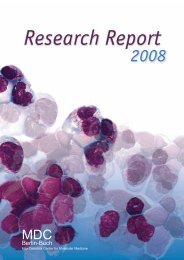You also want an ePaper? Increase the reach of your titles
YUMPU automatically turns print PDFs into web optimized ePapers that Google loves.
Gene Mapping and<br />
Identification in<br />
Monogenic and<br />
Complex Diseases<br />
André Reis<br />
Positional cloning is now widely used<br />
for the identification of gene defects<br />
that underlie inherited diseases. A<br />
necessary first step for positional<br />
cloning is the mapping of the gene<br />
locus that co-segregates within<br />
families with a particular disease or<br />
trait, which allows allocation of a<br />
specific chromosomal position to the<br />
responsible gene. Although mapping<br />
was initially developed for monogenic<br />
traits, it is now possible to locate<br />
genetic factors involved in the<br />
aetiology of complex diseases. The<br />
most powerful technique currently<br />
available is linkage analysis with<br />
highly polymorphic microsatellite<br />
markers, which involves an<br />
examination of the entire genome with<br />
a set of evenly spaced markers. This<br />
type of study is usually referred to as<br />
a whole genome scan.<br />
The Gene Mapping Centre is a<br />
specialised laboratory carrying out<br />
such high throughput genotyping for<br />
gene mapping in monogenic as well<br />
as complex diseases. We have<br />
developed various sets of well<br />
established markers from the<br />
Généthon reference genetic map with<br />
different marker densities to<br />
accommodate the requirements of<br />
special study designs. The laboratory<br />
is mainly funded through grants from<br />
the German Ministry of Science,<br />
<strong>Research</strong> and Technology (BMBF)<br />
and, since January 1997, we have<br />
participated in the German Human<br />
Genome Project. Additional funding is<br />
provided through a strategy-fund<br />
project, “genetics of complex<br />
diseases”, from the Helmholtz Society<br />
of National <strong>Research</strong> Centres. The<br />
laboratory is also available for<br />
mapping projects by other groups.<br />
28<br />
Mapping of complex diseases<br />
The main focus of the Gene Mapping<br />
Centre is mapping genetic factors in<br />
complex diseases. This type of study<br />
involves the analysis of large numbers<br />
of phenotypically well characterised<br />
families. Hundreds of markers are<br />
used for genotyping and sophisticated<br />
biostatistical analyses are subsequently<br />
required to identify the genetic loci<br />
that contribute to a complex disease.<br />
For this purpose we have established<br />
suitable techniques with an emphasis<br />
on automation of the experimental<br />
procedures. In <strong>2000</strong> we expect to<br />
reach an annual capacity of 2.000.000<br />
genotypes. Currently, mapping is<br />
based on highly-informative<br />
microsatellite markers but in the<br />
future analysis will shift more towards<br />
single nucleotide polymorphisms<br />
(SNPs). Two scientists are involved in<br />
project management, genotyping and<br />
technology development. One<br />
scientist concentrates on laboratory<br />
information management (LIM) which<br />
involves the integration of genotype<br />
and phenotype data and the<br />
biostatistical analysis of these data.<br />
This is done in close collaboration<br />
with the bioinformatics group (Dr. K.<br />
Rohde) and the University of Bonn<br />
(Prof. T. Wienker) where data analysis<br />
is carried out.<br />
A total of four genome scans for<br />
complex diseases have been<br />
completed and two further studies are<br />
under way. In a German collaborative<br />
study on the genetics of asthma (Wjst<br />
et al. 1999) 100 families with two<br />
affected siblings each, totalling 400<br />
subjects were investigated.<br />
Furthermore, in a study to identify<br />
genetic factors for susceptibility to<br />
psoriasis, 32 extended families with<br />
three or more psoriasis patients with<br />
in all, 500 subjects were investigated<br />
(Lee et al., in preparation). Each study<br />
required a total of approx. 200.000<br />
genotypes. Besides confirming<br />
already known loci in both studies, we<br />
have identified novel susceptibility<br />
loci, which are currently being<br />
investigated further with refined<br />
mapping and testing of positional<br />
candidate genes.<br />
Data analysis of two studies, for<br />
which we recently completed<br />
genotyping, is well advanced. In a<br />
study of the genetics of a subtype of<br />
schizophrenia we were able to identify<br />
new susceptibility loci and determine<br />
the mode of inheritance, at least for<br />
this subtype. The largest study in our<br />
laboratory to date is a European<br />
collaborative study of the genetics of<br />
juvenile myoclonic epilepsy. In total,<br />
we have investigated 130 families<br />
comprising 700 subjects. This is the<br />
first comprehensive genome-wide<br />
study of this type of epilepsy and we<br />
expect to gain important insights into<br />
the aetiology of both disease groups.<br />
Ongoing studies include two affected<br />
sib-pair studies, one on atopic<br />
dermatitis from a European<br />
consortium headed by the Charité<br />
Hospital (Prof. Wahn) and a second<br />
on juvenile obesity in collaboration<br />
with the University of Marburg (Prof.<br />
Hebebrandt). Finally, genotyping of a<br />
study of the genetic factors involved<br />
in hypertension, in collaboration with<br />
the Franz-Volhard-Clinic on the<br />
campus (Prof. Luft), is scheduled for<br />
the year <strong>2000</strong>. The study design is<br />
based on isolated populations and<br />
takes advantage of the restricted<br />
genetic heterogeneity in these<br />
populations. Running costs for all the<br />
studies are funded through additional<br />
external grants.<br />
Mapping of monogenic diseases<br />
In contrast to complex diseases,<br />
mapping of monogenic traits requires<br />
much less genotyping and, usually, it<br />
is sufficient to analyse 30-50 subjects.<br />
The statistical evaluation is different<br />
and often requires skilled<br />
interpretation e.g. haplotyping. In the<br />
four years since the lab opened, a total<br />
of 31 monogenic traits have been<br />
mapped in humans. For several of<br />
these the underlying gene defect has<br />
already been identified, completing<br />
the process of positional cloning. For<br />
instance, the gene for an autosomal<br />
recessive condition, Nijmegen<br />
Breakage syndrome, was found to be<br />
caused by mutations in a protein<br />
involved in DNA double-strand repair<br />
(Varon et al. 1998). This important<br />
finding has solved a long-standing<br />
puzzle and pointed research in this<br />
field in a new direction. In addition,<br />
we have also initiated mapping of<br />
monogenic traits in animal models,<br />
mainly the mouse. Several<br />
spontaneous and ENU-induced<br />
mutants have been mapped and, in<br />
two cases, the underlying mutations<br />
have also been identified. The<br />
majority of these projects originated<br />
in external laboratories in Germany<br />
but also from England, The<br />
Netherlands, Canada, United Arab<br />
Emirates and Australia.

















